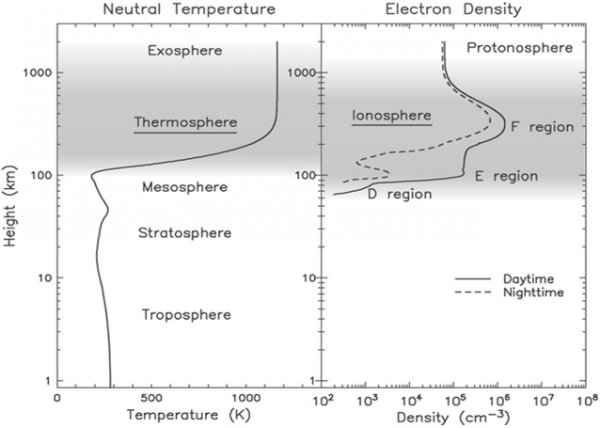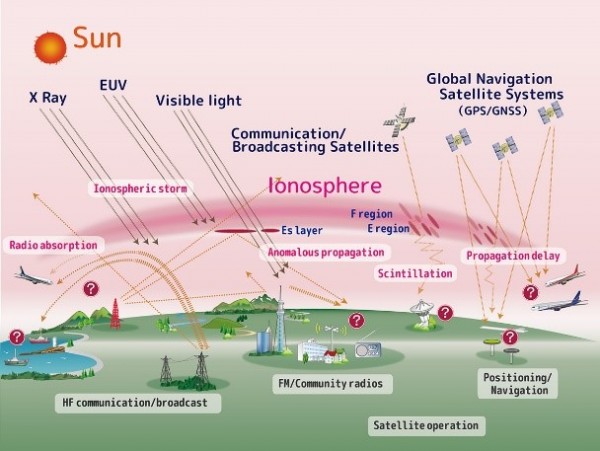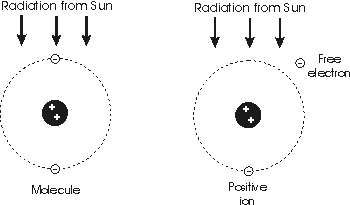What is the Ionosphere?
There overlaps the other atmospheric layers, from above the Earth. The air is ionized by the Sun’s ultraviolet light. These ionized layers affect the transmittance and reflectance of radio waves.

Fig.1 Layer of ionosphere [1]
The ionosphere is sub divided in following layer.
- D layer 50-90 Km
- E layer 100-125 Km
- F layer 150-500 Km
- F1 175-250 Km
- F2 250-400 Km
The ionosphere is a continually changing area of the atmosphere. Extending from altitudes of around 60 kilometers to more than 400 kilometers it contains ions and free electrons. The free electrons affect the ways in which radio waves propagate in this region and they have a significant effect on HF radio communications.
The ionosphere can be categorized into a number of regions corresponding to peaks in the electron density. These regions are named the D, E, and F regions. In view of the fact that the radiation from the Sun is absorbed as it penetrates the atmosphere, different forms of radiation give rise to the ionization in the different regions as outlined in the right summary table.
Ionospheric storm and space weather
Plasma density in the ionosphere is determined by the product of neutral atmospheric density (pressure) and the UV radiation intensity. Because the atmospheric density decreases and the UV radiation increases with altitude, the plasma density has a peak at altitudes of 300-400 km where many satellites such as International Space Station are orbiting. Radio waves transmitted from satellites at much higher altitudes such as GPS satellites must propagate through the ionosphere before reaching the ground. When the ionosphere is under disturbed condition, it may degrade the amplitude and phase of the radio waves and cause severe error in GPS signals. Therefore, it is very important to monitor and understand the ionospheric condition continuously.

Fig.2 Ionospheric effect on radio wave [2]
How is the ionospheric irregularity occurred?
The Ionization
The Sun emits vast quantities of radiation of all wavelengths and this travels towards the Earth, first reaching the outer areas of the atmosphere. In creating the ionization it is found that when radiation of sufficient intensity strikes an atom or a molecule, energy may be removed from the radiation and an electron removed, producing a free electron and a positive ion. In the example given below, the simple example of a helium atom is give, although other gases including oxygen and nitrogen are far more common.

Fig.3 The electron Ionization [3]
Radio Interference
When the solar wind mixes with the ionosphere, it becomes super-ionized, causing destructive, rather than productive, interference. The turbulence interferes with radio transmissions. In some instances, broadcasts can be picked up hundreds or thousands of miles from the transmitter. In others, signals cancel each other out, creating areas where reception is poor.
Ground-Based Interference
Particularly strong solar flares can affect electronic equipment on the ground as well as signals in space; any long metal object or wire can act as an antenna, turning the incoming stream of particles into an electric current. These currents may be relatively weak, adding noise to existing broadcasts; however, stronger currents can overload and burn out electronic equipment.
References
[1] Lutgens, Frederick K. and Edward J. Tarbuck (1995) The Atmosphere, Prentice Hall, 6th ed., pp14-17.
[2] Tatsuhiro Yokoyama, What is ionosphere, Applied Electromagnetic Research Institute of National Institute of Information and Communications Technology (NICT).
[3] Alessandro Volta et al, The Ionosphere and Radio wave Propagation, electronics+radio.
[4] J.T. Barett, Demand Media, How Solar Flares Affect Communication, Science in physics from Northeastern Illinois University.